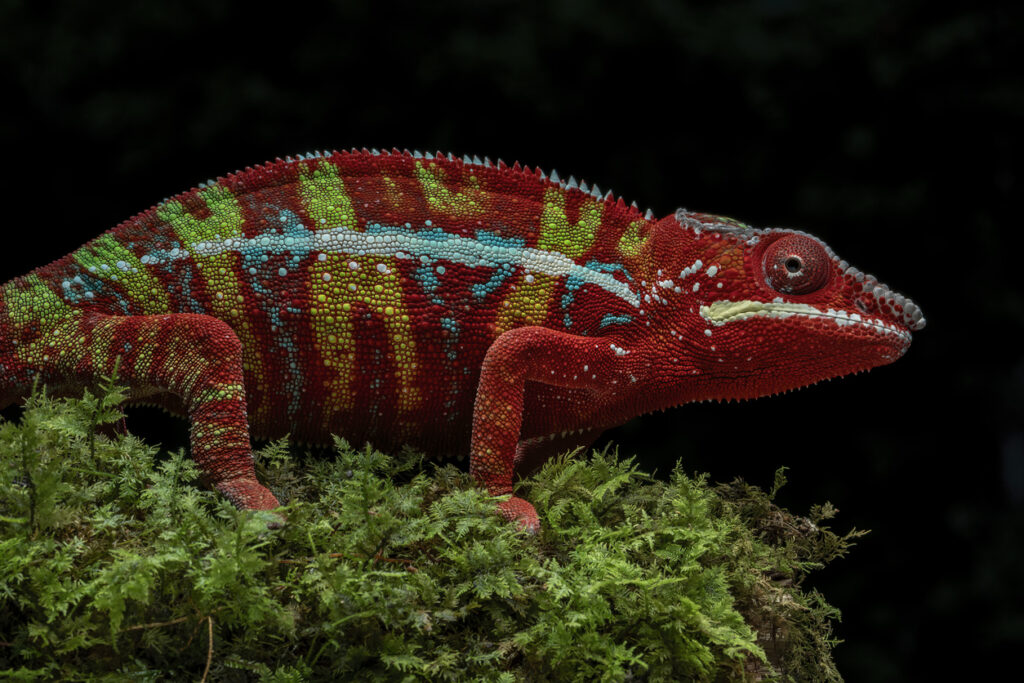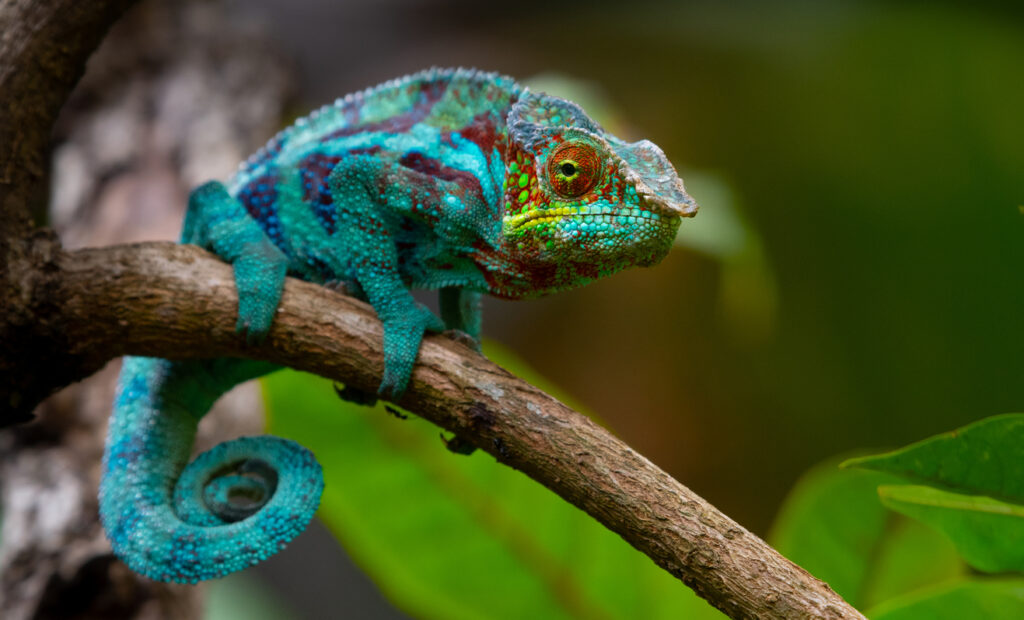We’re sure you’d agree that animals are capable of some impressive behaviour – whether it’s orcas working as a team to capture their prey or the humble crow using twigs and branches to extricate insects from trees. But as remarkable as these endeavours are, they pale in comparison to a chameleon’s ability to change colour at will.
“How do chameleons change colour?” is a question we get asked a lot about here at Blue Planet Aquarium, particularly the keepers who look after our Frog Zone exhibit, where most of our reptiles and amphibians are housed. And to be honest we’re not remotely surprised that so many people are interested in how our resident panther chameleons (Furcifer pardalis) can change colour seemingly in the blink of an eye, as it is a magical thing to witness firsthand.
Of course, there’s no great mystery to colour-changing chameleons and the whole process can be explained with a little science. So, that’s what we aim to do today, as we show you how chameleons change colour.
The science behind colour-changing chameleons
Of all ectothermic animals (which is a fancy way of saying animals that are cold-blooded), chameleons are perhaps the most famous. Indeed, if you were asked to name an animal that could change colour on Family Fortunes, we’d wager that most people would say chameleon as their top answer.
Like all ectotherms, a chameleon’s skin features specialised cells called chromatophores, which contain lots of different coloured pigments controlled by a muscle, that contracts or retracts to let out certain pigments. Indeed, there are multiple layers of these pigment-rich cells, including iridophores and erythrophores, which are what enable these remarkable creatures to change colour.
Of course, that doesn’t tell the full story. These pigmented cells alone aren’t what help chameleons to colour change seemingly at will; that’s all to do with their body temperature.
Chameleons can expand or contract their bodies to regulate their core temperature, and it’s this that triggers the pigmented cells to change colour. For instance, if they’re in the sun, they’re likely to relax and turn a pale colour to reflect the heat, whereas if they’re cold, they may contract, with their skin turning dark to absorb more warmth.

Why do chameleons change colour?
It may be nature’s greatest flex, but chameleons don’t just change colour for any old reason. Their ability to colour change is used as a way to regulate their body temperature, as well as a means of communicating signals to other chameleons – like when they’re looking to mate, for example.
We know what you’re thinking: don’t chameleons change colour as a form of camouflage? But this is actually one of the biggest misconceptions people have about these ingenious reptilians. While chameleons may inadvertently avoid would-be predators by continuously changing colour, they use their neat party trick to regulate temperature first and foremost.
Another reason why chameleons change colour is as a result of their changing mood and body cycle. For instance, an excited chameleon that is ready to mate might turn fully red, which serves as a way to attract prospective partners. On the other hand, when a chameleon is calm and relaxed, they’re likely to turn a pale green colour,
As chameleons age, their colour-changing abilities become more difficult and erratic, which is why you might see a mixture of colours and patterns displayed on older animals. Panther chameleons like those here at Blue Planet Aquarium typically live up to 5-7 years, although this may stretch to 10 for those raised in captivity.

Can all chameleons change colour?
Did you know that there are over 200 unique species of chameleons in the wild? Most live in sub-Saharan Africa and Madagascar, but they are found elsewhere, too, including southern Europe, India, and Sri Lanka.
What’s perhaps more interesting is the fact that of the 200 different species of chameleons, all are capable of colour-changing to some degree. This means that despite huge variances in size, shape and physical appearance, most of the world’s chameleons share a very special party trick.
We should caveat this by saying that not all chameleons are brightly coloured and capable of flicking from one colour to the next in the blink of an eye. While some animals are revered for their colour-changing prowess, others only alter their pigmented skin tone marginally, to the point where it may not even be noticeable to the naked eye.
See our very own panther chameleon
Here at Blue Planet Aquarium, we’re fortunate enough to have a resident panther chameleon (Furcifer pardalis), which is one of the most impressive colour-changers of the whole Chamaeleonidae family. Native to Madagascar, these impressive reptiles are among the most brightly coloured lizards in the world, with a distinctive colour-changing pattern extending along their bodies – which, helpfully, makes them very easy to spot!
Would you love to get up close and personal with these remarkable colour-changers? Then why not reserve a spot at Blue Planet Aquarium today? You’ll find our chameleons over at the Frog Zone exhibit.
